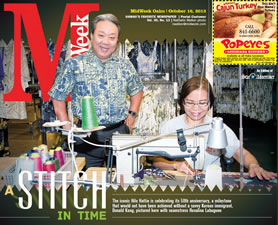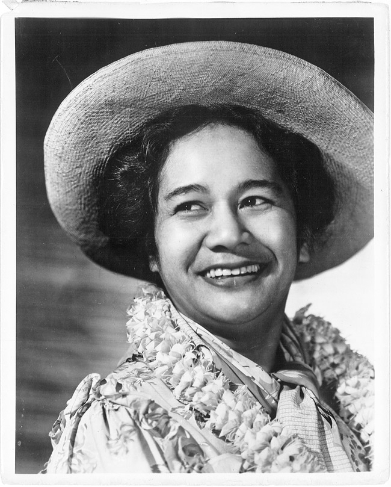Stitch In Time
As Hilo Hattie, “The Store of Hawaii,” celebrates its 50th anniversary this month, it marks the revival of a local brand that was almost lost five years ago. Instead of the end of an era, thanks to a Korean immigrant with a dream, today Hilo Hattie is alive and well.
Islanders might recall the anxious moments in 2008 when the former owners of Hilo Hattie filed for bankruptcy and went through painful reorganization to address mounting debt, changing market conditions and rising costs. Its flagship store on Nimitz Highway even was put up for sale.
mw-cover-101613-hilohattie-4
To some islanders who didn’t follow the news of negotiations to save the company, Hilo Hattie became a passing memory like the legendary personality for whom the business is named. As far as they’re concerned, Hilo Hattie did its last hula hop into oblivion.
But as Hilo Hattie president-CEO Donald Bum Sik Kang lights the candles on a golden anniversary cake, he ignites hope for the future. Thanks to his leadership, rein-vestment in the company by creditors, the dedication of 225 employees and the support of the community, Hilo Hattie is still hopping.
As any organization that survives a half century knows, it is not an easy journey given the fragility of our economy and the whims of the market.
What made the difference for Hilo Hattie? How does it hope to navigate the next 50 years? How can aloha apparel and made-in-Hawaii marketing lead the way to global prominence?
Put on your favorite aloha wear, sip locally grown coffee and let us tell you.
The first Hilo Hattie store was opened in 1963 by Jim Romig on a stretch of road between Lihue and Kapaa on Kauai. The sign out front read “Kaluna Hawaii Sportswear.” It was the genesis of a retail concept specializing in made-in-Hawaii fashions and gifts.
Its first manufacturing center, known as Hawaiian Wear Unlimited, opened in 1965 in Honolulu, where Ward Warehouse is today. The company shuttled visitors from Waikiki every day with one van and was known as the “home of the $3.95 aloha shirt.”
In the ensuing years, Hilo Hattie went through major expansion and growth to become a flourishing retailer, distributor and Hawaii’s largest aloha apparel manufacturer. Fame and fortune came at a price when, in 2008, the company found itself in financial debt and filed for bankruptcy reorganization.
The white knight came in the form of a Hilo Hattie vendor who aspired to be Hawaii’s top travel retailer. Enter Donald Kang.
Kang, an immigrant from Seoul, moved to Hawaii in the 1980s to pursue opportunities in the U.S. He started a modest business with one kiosk in the International Marketplace in Waikiki. That grew to seven shops in 15 years and eventually to a large manufacturing and wholesaling venture named Royal Hawaiian Creations. The Iwilei-based enterprise diversified from a simple garment manufacturer to become one of Hawaii’s largest manufacturer, wholesaler and import/exporters of apparel, accessories and food products. One of its major accounts was Hilo Hattie.
Kang, 58, a founder and director of Ohana Pacific Bank, recalls, “I used to pass by here (flagship store on Nimitz Highway) every day and think, ‘Just like Hilo Hattie, I’d like to sell the best Hawaiian products to our visitors.’ You have to have a dream and you have to focus on it in order to achieve it.”
That fateful opportunity came in 2009 when locally owned Pomare Ltd., parent company of Hilo Hattie, was purchased out of bankruptcy by Kang and other creditors. Kang’s business and management acumen were put to the test as he worked to bridge retailing and manufacturing to create what is today a vertically integrated company specializing in made-in-Hawaii brands and products.
Men’s, women’s and children’s clothing continue to be strong lines, supported by consumers who, for the past 10 years, voted Hilo Hattie “Best Aloha Apparel Store” in Hawaii.
Besides Royal Hawaiian Creations’ labels, the seven statewide Hilo Hattie stores also carry distinctive designs by Mamo Howell, Kim Taylor Reece, Iolani, Wyland and Taylor Wily. Singer Amy Hanaialii has baby accessories featured among its infant inventory. Maui Divers is its jewelry showcase.
So under the Hilo Hattie brand are sub-brands that reinforce its marketing position as “The Store of Hawaii.” Gourmet food items, home accessories and beauty products have been added to the line.
As Kang puts it, “There is a big demand for Hawaii products even outside of the state’s limited market. But in order to have an international vision, we must be true to who we are at home.
“I was attracted by the challenge to turn around Hilo Hattie,” he adds. “It took time and a lot of reinvestment to get it fixed. Now it’s time to make money!”
His optimism couldn’t have come at a better time.
As tourism maintains its steady course of recovery and expands new markets in Asia and the Pacific, providers of the Hawaii cultural experience become ambassadors and storytellers. Aloha begins there.
The 33,000-square-foot flag-ship store on Nimitz Highway welcomes up to 1,500 visitors each day. About 40 percent of those visitors arrive by free shuttles from Waikiki.
Live music, in-store events and shopper amenities, such as the new Kona Bean Café, add to the Hilo Hattie experience. During October’s 50th anniversary celebration, there is a lot to entice kamaaina and visitors to the stores in Honolulu (Nimitz and Ala Moana Center), Lihue, Hilo, Kona, Kihei and Lahaina.
Edward Kang, the CEO’s son who works in the sales and marketing department, notes there are 50 percent discounts on selected items, aloha shirts for $19.63 celebrating the year Hilo Hattie was founded, kamaaina discounts of up to 25 percent, social media contests and cause-related drives to help agencies such as Hawaii Foodbank.
Richard Yoo, a nephew who also is on the sales force, boasts the fine selection of aloha shirts, especially those made of classic sandcloth with wrinkle-free properties and wash-wear durability.
“These are real coconut buttons,” he points out.
It’s an important detail when value-conscious consumers seek product authenticity. The made-in-Hawaii cache is a priceless commodity.
E-commerce is another growth area for Hilo Hattie, as shoppers search for Hawaii fashions and products on the Internet. Virtual sales on hilo-hattie.com account for millions of dollars in revenue.
As CEO Kang continues his dialogue with us, even as English is his second language, we realize where his heart is: It’s squarely in Hawaii, with the desire to project and preserve Hawaiian culture.
He says, “We want to focus on the authentic aloha experience by bringing more culture into the retail environment. We have plans – and you’ll see them unfolding soon – to deliver on that promise.”
In the next 50 years, the company also is poised to expand its wholesale and import/export activities.
“I want to be the ambassador of aloha for Hawaii,” he says.
We gaze at a poster of the original Hilo Hattie on the wall and realize he is reflecting the spirit and the tradition of Clarissa “Clara” Haili, the schoolteacher-turned-comic hula dancer who popularized the tune When Hilo Hattie Does the Hula Hop. She was an iconic figure in her bright printed muumuu wrapped with a scarf around her hips. She put Hawaii on the map with her charm and whimsy.
At times like these, it’s encouraging to reflect on the simple things that make life worthwhile and remind us who we are. Local brands that stick around and continue to nurture Island values keep it real for us.
Hilo Hattie should not be taken for granted. It should be taken to heart.
Hauoli la hanau, Hilo Hattie.







